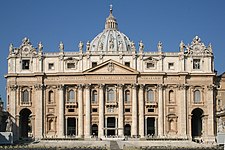Our website is made possible by displaying online advertisements to our visitors.
Please consider supporting us by disabling your ad blocker.
Catholic Church
Catholic Church | |
|---|---|
| Latin: Ecclesia Catholica | |
 | |
| Classification | Catholic |
| Scripture | Bible |
| Theology | Catholic theology |
| Polity | Episcopal[1] |
| Structure | Communion |
| Pope | Francis |
| Administration | Roman Curia |
| Particular churches sui iuris | 24: Latin Church, and 23 Eastern Catholic Churches |
| Dioceses | |
| Parishes | 221,700 |
| Language | Ecclesiastical Latin and native languages |
| Liturgy | Western and Eastern |
| Headquarters | Vatican City |
| Founder | Jesus, according to sacred tradition |
| Origin | 1st century Holy Land, Roman Empire[2][3] |
| Members | 1.313 billion (2017)[4] |
| Clergy | |
| Official website | Holy See |
The Catholic Church is the largest Christian church in the world. It has over one billion members, and is the world's largest religious group.[5][6] Its members believe that Jesus Christ started the Catholic Church 2,000 years ago. The Church’s headquarters are in the Vatican City, a sovereign state governed by the Holy See that is an enclave of Rome, Italy.[7]
The word "catholic" comes from the Greek word καθολικός (katholikós), which means "universal." This word was first used in the Nicene Creed. Often, the word "Roman" is added before “Catholic” because Vatican City is a country inside of Rome, Italy. Members of the Catholic Church call themselves Catholics.
Almost half of all Catholics are in Latin America. The continent with the second-largest number of Catholics is Europe. Millions of Catholics live in other places all over the world.
The Catholic Church is led by the Pope, the Bishop of Rome, who lives in the Vatican City. According to Catholics, the Church is guided by the Holy Spirit, who also guides the Pope. The Church teaches that the Pope cannot be wrong when he when speaks officially on the subject of Catholic faith and morals. This is called "infallibility," and Popes have used it throughout history, but very rarely. Examples include the Tome of St. Leo, the declaration of the Immaculate Conception, and various anathemas (religious condemnations issued by the Popes against certain heresies).
The Catholic Church teaches that the first Pope was Saint Peter, who was a disciple of Jesus Christ. The current pope is Pope Francis.
- ↑ Marshall, Thomas William (1844). Notes of the Episcopal Polity of the Holy Catholic Church. London: Levey, Rossen and Franklin. ASIN 1163912190.
- ↑ Stanford, Peter. "Roman Catholic Church". BBC Religions. BBC. Retrieved 1 February 2017.
- ↑ Bokenkotter, 2004, p. 18
- ↑ "Presentation of the Pontifical Yearbook 2019 and the Annuarium Statisticum Ecclesiae 2017". Holy See Press Office. 6 March 2019. Archived from the original on 7 March 2019. Retrieved 6 March 2019.
- ↑ "Vatican statistics report church growth remains steady worldwide". National Catholic Reporter. 2 May 2014. Archived from the original on 1 July 2014. Retrieved 30 May 2014..
- ↑ Sandra Brenneman Oldendorf 2011. Religious diversity and children's literature: strategies and resources, p 156.
- ↑ Which Catholic Church?
Previous Page Next Page


